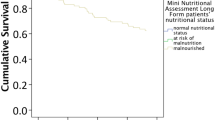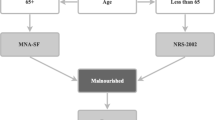Abstract
Objective: To assess the prevalence of old people at risk of undernutrition according to the Mini Nutritional Assessment (MNA), characterise the at risk group with regard to nutritional state, energy intake, and physical and mental functioning, and to assess the consequences of the MNA score over a 6 month period.
Design: A cross-sectional prospective study.
Setting: The clinic of a general practitioner.
Subjects: Ninety-four patients 65+-y-old with no acute illness contacted at the clinic. Sixty-one subjects (65%) agreed to participate at baseline and 34 (56%) showed up at the follow-up 6 months later.
Results: At baseline, 23 (38%) participants were assessed as being at risk of undernutrition (17–23.5 MNA points). The remaining were classified as well-nourished (>23.5 MNA points). The 23 participants at risk had a higher prevalence of body mass index (BMI) <20 kg/m2 (44 vs 11%, P<0.001) and insufficient energy intake (36 vs 9%, P<0.05), compared with the well-nourished group. Also, they had a higher need of meals-on-wheels (39 vs 8%, P<0.01) and home-care for shopping (48 vs 18%, P<0.05) at baseline. At the 6 months' follow-up, there was a tendency to a higher non-participation rate among the participants assessed at risk of undernutrition at baseline (44 vs 18%, 0.05<P<0.1), compared with the well-nourished group. There was a tendency to a higher prevalence of hospitalisation (38 vs 19%, 0.05<P<0.1) in the at risk group.
Conclusion: MNA seems to be a useful tool to identify old people who need help from the public sector. However, many in the group at risk of undernutrition already have low BMI values. This might have influenced the findings.
European Journal of Clinical Nutrition (2001) 55, 1028–1033
This is a preview of subscription content, access via your institution
Access options
Subscribe to this journal
Receive 12 print issues and online access
$259.00 per year
only $21.58 per issue
Buy this article
- Purchase on Springer Link
- Instant access to full article PDF
Prices may be subject to local taxes which are calculated during checkout
Similar content being viewed by others
References
Altman DG (1995) Practical Statistics for Medical Research London: Chapman & Hall
Andersen LT, Jensen H & Haraldsdóttir J (1996a) Typical weights of foods Scand. J. Nutr. 40 (Suppl 32), S129–S152
Andersen NL, Fagt S, Groth MV, Hartkopp HB, Møller A, Ovesen L & Warming DL (1996b) Dietary Habits in Denmark 1995 Publication no. 235 National Food Agency of Denmark (in Danish)
Beck AM & Ovesen L (1999) Modification of the nutrition questionnaire for elderly to increase its ability to detect elderly people with inadequate intake of energy, calcium, vitamin C and vitamin D Eur. J. Clin. Nutr. 53 560–569
Beck AM, Ovesen L & Osler M (1999) The ‘Mini Nutritional Assessment’ (MNA) and the Determine Your Nutritional Health Checklist (NSI) as predictors of morbidity and mortality in an elderly Danish population Br. J. Nutr. 81 31–36
Chumlea C (1999) The state of the Mini Nutritional Assessment? Nutrition 15 159–161
Compan B, Di Castri A, Plaze J-M & Arnaud-Battandier F (1999) Epidemiological study of undernutrition in elderly patients in acute, sub-acute and long-term care using the MNA J. Nutr. Health Ageing 3 146–151
George LK (1991) Psychiatric Disorders in America New York: Free Press
Guigoz Y, Vellas B & Garry PJ (1994) Mini Nutritional Assessement: a practical tool for grading the nutritional state of elderly patients Facts Res. Gerontol. (Suppl 2), 15–81
Hof MA, Hautvast JGAJ, Schroll M & Vlachonikolis IG (1991) Design, methods and participation Eur. J. Clin. Nutr. 45 (Suppl 3), 5–22
Reuben DB, Greendale GA & Harrison GG (1995) Nutrition screening in older persons J. Am. Geriatr. Soc. 43 415–425
Saletti A, Johansson L & Cederholm T (1999) Mini Nutritional Assessment in elderly subjects receiving home nursing care J. Hum. Nutr. Diet. 12 381–387
Vellas B, Guigoz Y, Garry PJ, Nourhashemi F, Bennahum D, Lauque S & Albarede J-L (1999) The Mini Nutritional Assessment (MNA) and its use in grading the nutritional state of elderly patients Nutrition 15 116–122
WHO (1985) Energy and protein requirements: reports of a FAO/WHO/ UNU expert consultation Technical Report Series no. 724 Geneva: WHO
WHO (1995) Physical status: the use and interpretation of anthropometry; report of a WHO expert committee Technical Report Series no. 854 Geneva: WHO
Willet W (1998) Nutritional Epidemiology, 2nd edn. New York: Oxford University Press
Author information
Authors and Affiliations
Corresponding author
Rights and permissions
About this article
Cite this article
Beck, A., Ovesen, L. & Schroll, M. A six months' prospective follow-up of 65+-y-old patients from general practice classified according to nutritional risk by the Mini Nutritional Assessment. Eur J Clin Nutr 55, 1028–1033 (2001). https://doi.org/10.1038/sj.ejcn.1601266
Received:
Revised:
Accepted:
Published:
Issue Date:
DOI: https://doi.org/10.1038/sj.ejcn.1601266
Keywords
This article is cited by
-
Nutrition assessment and geriatric associated conditions among community dwelling Iranian elderly people
BMC Geriatrics (2020)
-
The Norwegian dietary guidelines and colorectal cancer survival (CRC-NORDIET) study: a food-based multicentre randomized controlled trial
BMC Cancer (2017)
-
Malnutrition, functional ability and mortality among older people aged ⩾60 years: a 7-year longitudinal study
European Journal of Clinical Nutrition (2016)
-
Factors associated with poor nutritional status among community dwelling Lebanese elderly subjects living in rural areas: Results of the AMEL study
The Journal of nutrition, health and aging (2014)
-
Validation of the modified mini nutritional assessment short-forms in different populations of older people in Poland
The Journal of nutrition, health and aging (2014)



